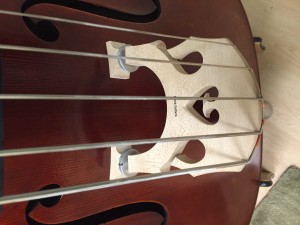I’m going to write today about the virtues of a 5-string bass. In North American orchestras, when extended range is required, we most often see extensions (most often down to the note “C”). An extension involves lengthening the fingerboard above the nut on the E-string in order to gain two whole steps below the open E-string. This requires the addition on an extension and, when the pitches are set by gates, the addition and tuning of the gates. This can add close to $2,000 to the cost of the bass and it can cause additional maintenance headaches should the gates need adjustment.
In Europe, you most often see 5-string basses. The addition of a low B-string gives you the increased range without any of the complexities of the extension. As long as the bass is purpose-built as a 5-string, the string spacing and breakover angles should feel very comfortable to bassists used to a 4-string. The bass itself must be of high enough quality to support the lowest frequencies.
We find ourselves placing 5-string basses with local schools and students with increased frequency. It’s a development I wholeheartedly support!


Recent Comments